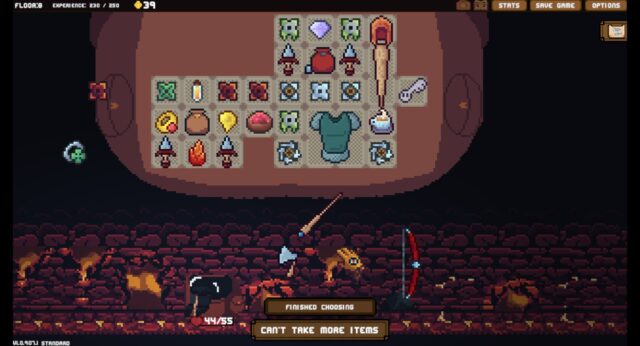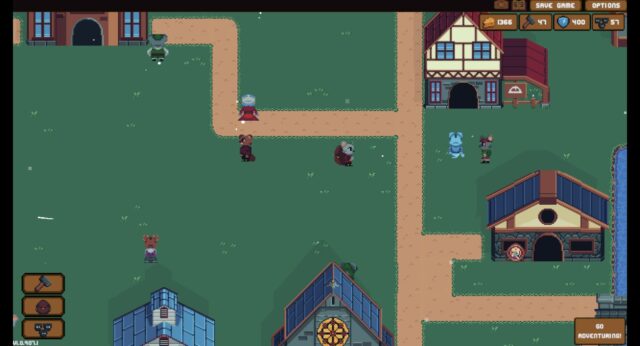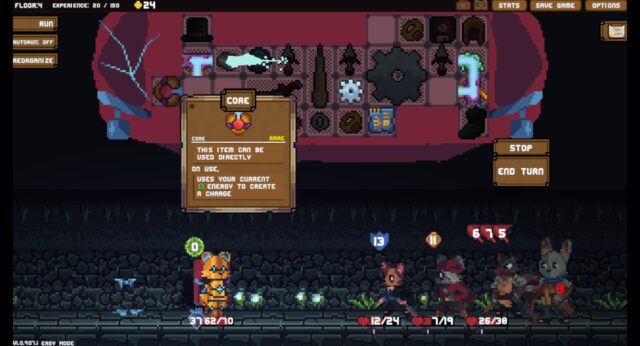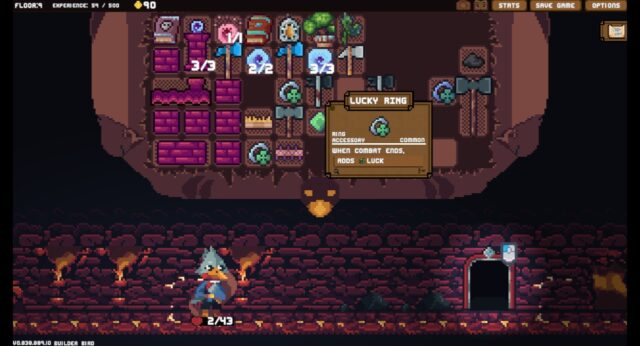Backpack Hero Review
Have Organization, Will Travel
There are masters of packing that can fit days, if not weeks, of things into their luggage for travel around the world. Jaspel’s Backpack Hero finds inspiration in this level of organizational feats and lengthens it to a deep roguelike RPG. The game’s core of finding different item combinations offers plenty of possibilities with hundreds of items available to make tons of builds with. But while tinkering with builds remains a highlight, the rest of the presentation feels lacking at times.
Backpack Hero‘s story follows Purse, an adventurous young mouse who dives into the nearby dungeon to get treasure for her hometown of Haversack Hill. Purse is also searching for clues to what happened to her mother, who went missing in the dungeon. Her mother’s disappearance set off a chain reaction resulting in Haversack Hill’s economy plummeting and many inhabitants leaving. While on an expedition, Purse finds a magic backpack that allows her to keep more treasures found in this consistently shifting dungeon. These treasures are used to revitalize Haversack Hill’s economy and spur hope to rekindle the glory days of the town. Townspeople function as either quest givers or just give hints as to what to build next for unlocking new items.
Along the journey, four additional characters join Purse with their own unique backpacks. Purse starts with a small backpack that can be expanded one block at a time, up to four at each level up, to stretch into many different combinations. Another character uses pocket dimensions and preset square shapes to build their backpack, while also being able to use instruments to charm enemies. Another collects items that shuffle into their hand like cards at five per turn that are then discarded from their pack. There’s even a character that uses a forward moving electrical current that can be altered with toggles and switches to make everything feel like an engineering puzzle. Finally, a summoner brings out helpful animals that can carry their own backpacks using treats that can strengthen their abilities. Every backpack fundamentally changes the way to view how the items interact in a challenging and interesting way. Backpack Hero is a game that rewards players for doing something new, as each build feels like a mini logic puzzle to conquer. Trying something new provides some resources for the town or progression via quests, but the fun in trying new combinations feels like its own reward.
Using different characters to fight is a delight. Backpack Hero has plenty of viable builds; some are broken in ways that shouldn’t work, but in an enjoyable manner. Combat features enemies that telegraph their actions, whether it is attacking, debuffing, or blocking, making it easy to plan actions around. By default, players have three energy points to use. Items use zero to three points of energy, with zero-energy items generally either being limited-use consumables or only permitted one use per turn. Finding out which items mesh together is done through a lot of trial and error. Being able to build around something rare and powerful is amazing, though the random chances involved in obtaining items makes relying on one final piece to complete a build an unwise choice. The game also discourages players from swapping between different damage types, as the resources required to do so is very difficult.
Magic needs a lot of interconnecting manastones to work as they have their own power source, with archery, open spaces in the backpack are needed for building up damage, while being adjacent to the bow, as if they were being shot from the backpack itself. Some strong weapons just take up a lot of space, while many quick use items either disappear quickly or are weak by themselves. Gems and accessories, when placed strategically, can overhaul weak and common weapons into boss killers. Some builds may seem strong initially but will meet enemies able to counter their strategy, such as enemies with spikes that deal return damage for each strike. However, there’s a lot of fun ways to mix and match everything to work in the player’s favor, especially in the early goings.
The quests given by townspeople work like mini tutorials. They begin by swapping out the default starting equipment with something specific to expand the player’s understanding of how to create their own builds. The majority of these swaps lead to specific item sets such as hammers, magic, or archery being featured, but some also force players to carry around a relic with limited usefulness like an albatross until the run is completed. Quests are necessary for progress, as they provide the lost sparks necessary for one of Haversack Hill’s inhabitants to make keys that grant access to later floors in the dungeon.
The quests’ tutorial-like nature means they end after reaching a certain depth in the dungeon, with each quest’s final boss leading back to town rather than further into the dungeon. When entering the dungeon and when descending to new floors, players are given the choice of two different areas to explore, each with its own set of chests, encounters, and events. Every third floor, however, involves a boss fight, with a total of nine floors when everything is fully unlocked. Boss fights give players a choice of relic of the same group as those obtained in quests, except they can be discarded if they aren’t found to be useful. Many will end up being discarded as they are just too niche to be useful most of the time. These boss floors are also where to find a healer, and a character named Parcel who carts some of the treasure back to Haversack Hill. Parcel is helpful because it’s much easier to send components needed to unlock new items or quests back in town with him than lugging them around with limited space.
Players are also tasked with building Haversack Hill back up from scratch. As the population grows, craftsmen will join with plans to create their specialty stores. These buildings feature more quests and items to unlock for the dungeon, as well as boosting materials found while adventuring. Creating more buildings to expand item selection requires collecting appropriate materials from the dungeon. Selling items will net players a small amount of materials, but most will be gained from diving into the dungeon, with more materials found the deeper they go. If the player is defeated, they can pick one item from their pack to bring home so there’s always a small sense of progression even in failure. Balancing between building a backpack full of useful gear and grabbing enough materials to bring back to improve Haversack Hill is an interesting trade-off that makes the early game a lot of fun.
Backpack Hero counters the relative ease of its early game with a huge ramp up in difficulty that is tough to get over without a great build and some luck. Random encounters on the third floor have as much health as prior bosses while the new bosses can have up to six or seven times more health. Luckily, there are plenty of opportunities to find something that can win this battle of attrition, or even deal outrageous amounts of damage in just a few turns.
Careful planning will allow players to get through difficulty spikes, though enemy design and health levels can be frustrating at times. However, random loot causes problems since some drops are needed for progression. These required drops are not guaranteed and many runs may be needed before finding all of them, making burnout through frustration a real possibility.
Backpack Hero’s sprite-based visuals are rather pedestrian in animation, with most of the detailing going into the items and colouring of the backpack. Floor maps have little detail, while the backgrounds within the dungeon don’t change while the character is moving through them. In contrast with the static backgrounds, each floor has it’s own traversal and battle music. Unfortunately, this music loops very quickly making it hit or miss as some of them are catchy, while others grate on the nerves after a short time. Sound effects are serviceable but lack any particular nuance. This style of presentation does allow for players to focus on strategy and planning, but does make everything else feel secondary.
There’s plenty to enjoy from balancing the equipment of Backpack Hero. Like fitting everything into a suitcase, figuring out where everything slots in can be very satisfying. However, there are plenty of rough edges. The story mode falls flat fast and the presentation fades quickly into the background. The gameplay loop is so richly varied that finding new ways to break the game with a build is always entertaining, it is just a shame that the presentation surrounding this gameplay is so lackluster.
Disclosure: This review is based on a free copy of the game provided by the publisher.


Plenty of replayability through equipment specialties
Unique combinations of items that can end up breaking the game in a fun way
Fitting items in to create new builds can be addicting
The presentation is plain
Story mode feels like an afterthought
Random chance loot drops for story progression is a rough idea











Recent Comments